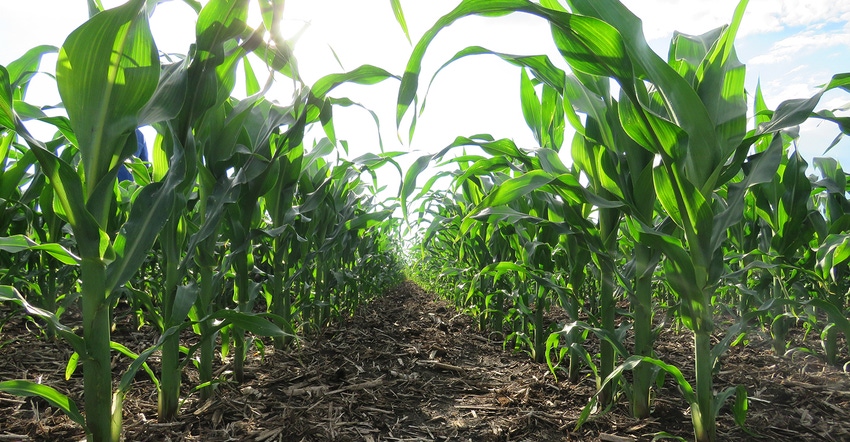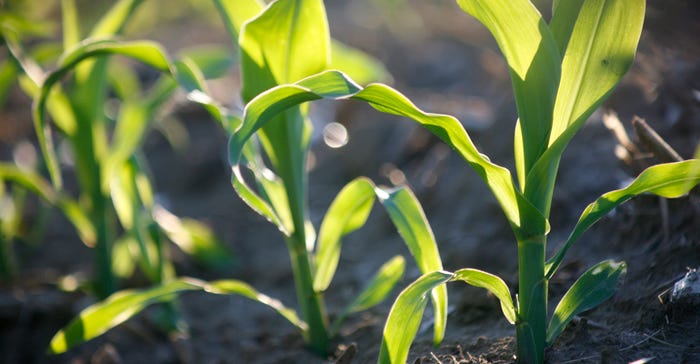February 27, 2019

A glance at Gene and Betty Steiger’s trophy case reveals the couple’s longevity and passion for producing bin-busting corn yields. Since 1990, the Steigers have entered the national and state contests, bringing home the top prize several times.
For example, Gene won first place in the Double A no-till, strip-till non-irrigated category in the National Corn Growers Association yield contest in 2018. His total entry maxed out at 297.2 bushels per acre, while Betty received first in the conventional category with 304.2 bushels per acre. Those numbers followed yields of 297.6 bushels per acre in 2011, 278.9 bushels per acre in 2012, 315.2 bushels per acre in 2013 and 314.1 bushels per acre in 2017.
The Steigers, with their son Paul, raise 325 acres of corn, 220 acres of soybeans and 105 acres of hay near Bloomington, Wis. In the past five growing seasons, they have averaged 228 bushels per acre on mostly conventional and no-till ground featuring Tama soils.
The Grant County farmers rely on soil testing in 2.5-acre grids and take five to six samples on their contest plot. They apply nitrogen, phosphorus, potassium and certain micronutrients in variable rates, according to soil samples, in their effort to produce top yields for the national contest.
“Our ultimate goal each year is trying to harvest 300-plus bushels per acre,” Gene says. “Looking back at last year, the most critical components for hauling more bushels across the scales were choosing the right hybrid and planting date. Depending on the weather forecast, dry soil conditions and if the soil temperature registers above 50-plus degrees F, we like to put kernels in the ground between April 21 and May 1.”
 TOP PRODUCER: Gene Steiger farms in Grant County, Wis.
TOP PRODUCER: Gene Steiger farms in Grant County, Wis.

He prefers to deep-chisel in the fall, runs duals on all his equipment, and limits compaction problems by staying out of the fields when it’s wet. Following a fairly strict corn-soybean rotation has produced the best results.
The hybrid selected for the 2018 contest entry plot measuring 10 to 12 acres was DKC64-34 RIB, treated with Acceleron, to enhance early to midseason disease control. Kernels were dropped at a population of 42,000 plants per acre in 30-inch rows with a John Deere 12-row 1760 Vac Conservation MaxEmerge II planter. The plot was harvested Oct. 15 at 27.3% moisture with a count of 18 rows on each ear.
Counting more bushels
To control foxtail and giant ragweed, Gene relied on a postemergence application of 1 pint of Harness and 2.8 pints of TripleFlex per acre. Foliar feeding is another essential tool for boosting yields. He went with 1 quart of Max-In ZMB per acre at the VT to R1 growth stage. The fungicide treatment included 4 ounces of Priaxor per acre aerially applied at the V5 to V7 growth stage.
“Healthy plants deliver big-time yields,” Gene says. “Every year we gather tissue samples and soil test for micronutrient deficiencies, and make sure to fill requirements as needed. But last summer, Mother Nature threw some curves and became a major player in our corn crop. Excessive rainfall, up to 58 inches, leached away some of the nitrogen, which reduced yields by 10 to 15 bushels per acre.
“Entering the contest for three decades provides a bird’s-eye, microscopic result of what our soils are capable of. This endeavor also allows us to compare yields. We’re able to examine what technologies are being used in the field, plus check out tillage practices with growers across the country. I feel that chatting with other producers is a perfect opportunity to pick up a nugget or two that might get you into the winner’s circle.”
Favorable intentions
After watching the TV reality show “Corn Warriors,” Zac Soltvedt decided to participate in the 2018 Wisconsin Corn Growers Association yield contest. His entry topped out at 284.25 bushels per acre, less than 10 bushels below the winning total in the northern division of the Badger State.
Soltvedt farms 350 acres of corn and soybeans with girlfriend, Amber Bellows, near Seymour. His dad, Jim, and brother Nate help during busy times, while his mother, Jodi, handles bookkeeping. He also operates a custom application enterprise, G&Z Farm Services, which sprays 11,000 acres of corn, soybeans and wheat each year.

KEYS TO HIGH YIELDS: According to Zac Soltvedt of Seymour, Wis., uniform emergence and weed control are the biggest keys to achieve above-trend yields.

“Our corn program, which has averaged 190 bushels per acre the past five years, revolves around minimum till on 150 acres,” Soltvedt says. “The 10-acre contest plot, part of an 80-acre field consisting of Onaway silt loam soil, is rotated with soybeans every other year. My main production criteria are to simply select a top variety and plant it on an area I feel will do well.”
Soltvedt’s fall fertility package included average variable rates of 100 pounds of potash and 150 pounds of DAP per acre. At planting, he applied 12 gallons of 32% N and 3 gallons of ammonium thiosulfate per acre. Fertilizer placement on the planter is set up at 2 inches to the side and 2 inches below the seed. During this pass, he also added 4 gallons per acre of 6-24-6 with micronutrients in the furrow.
“Uniform emergence and weed control are the biggest keys to achieve above-trend yields in this area,” Soltvedt says. “To eliminate early flushes of broadleaves, grasses and maintain clean fields throughout the season, I rely on Acuron herbicide at a rate of 2.5 quarts per acre.”
 UP-AND-COMER: Zac Soltvedt farms in Outagamie County, Wis.
UP-AND-COMER: Zac Soltvedt farms in Outagamie County, Wis.

This past year, Soltvedt switched to a full precision planter. which worked better in minimum till conditions. On May 25, he dropped 35,000 kernels of Legacy L3617-VT2 per acre in 30-inch rows with an eight-row Kinze model 3000 planter. The plot was harvested Nov. 2 at 24% moisture, showing a test weight of 53 pounds with an average of 16 rows on each ear.
The Outagamie County farmer notes that treating seeds with zinc helped eliminate some early stress on the young plants. Another shot of fertilizer was put on during the growing season. These two passes were 20 gallons of 29-0-04 and 1 gallon of micro mix per acre at V5, and 15 gallons of 29-0-0-4 and 1 gallon of micro mix per acre again at V12. Foliar feeding included Prairie Gold at a rate of 0.1 gallon per acre at the V, V12 and post-tassel stage. To help control northern corn leaf blight, Soltvedt applied 6 ounces of Priaxor per acre with a Hagie sprayer during tassel time.
“I decided not to put excess fertilizer on the plot, just split the applications when the plants needed it,” he says. “The profit margin per acre was significantly better, perhaps by 20% on the contest area. Looking back, last year was OK for corn production but really not all that great.
“Adapting to different situations, maintaining a close eye on all management practices, planting when the first opportunity opens and tweaking overall fertility are the top-priority items for 2019,” he adds. “For me, the contest is a constant learning curve. I was satisfied with my overall yield but plan to win this year.”
10 tips for winning corn yield contests
About 90 million acres of corn are planted across the U.S. every year. The odds of predicting the top yields at harvest are about as good as trying to hit the center of a dart board two out of three times.
However, by implementing best management practices, growers can lay the foundation to warrant bragging rights and gain bin-busting yields. Here are 10 tips provided by BASF that may help producers add bushels and boost profits — and potentially reach the top spot in the National Corn Growers Association yield contest or their state yield contest.
1. Test soil fertility at least every other year. Determine the optimum nitrogen rate and timing by balancing the rate of uptake needed during key growth stages, and calculate how much nitrogen could be lost during periods of wet weather.
2. Select hybrids from more than one maturity and genetic group to provide risk management and spread out the workload at planting and harvesttime. Research hybrids with consistently high-yield ratings, good standability and appropriate maturity ratings for your area.
3. Plant hybrids that have shown good yield trial results, along with tried-and-true hybrids. Seed genetics with built-in herbicide tolerance traits can significantly enhance control of a broad range of tough-to-manage grasses and broadleaf weeds. Diversify hybrid choices to spread the risk with a range of maturities and insect and disease susceptibilities.
4. Invest in a seed treatment to protect against diseases, insect pests and nematodes that do not allow young plants to get off to a good start. To protect against early-season pests, consider a systemic seed treatment component along with a biological for root protection and additional modes of action for dual protection.
5. Consider optimal planting dates and then focus on geography, weather and individual field conditions, such as drainage, when deciding when to plant. Mudding in seed can result in the loss of valuable time spent struggling with stuck equipment. This creates yield loss due to poor stands and may cause soil compaction issues later in the season.
6. Check population rates because there are many variables to consider, including soil types, different hybrid maturity dates and yield potential on various soils. Seed rate decisions are best made field by field. Also, consider row width when determining the final population.
7. Start with a clean field by investing in season-long weed control. Plant into weed-free fields using preplant and preemergence residual herbicides. Always aim to control weeds before they reach 3 inches in height. If weed escapes occur, stay clean with an effective postemergence herbicide.
8. Protect plant health by using fungicides. Following this management practice helps prevent disease pressure from negatively impacting yields, especially in a no-till situation with higher residue or in fields that were planted to corn the prior year.
9. To help guide treatment decisions and economic thresholds, check fields early and often for emerging weeds, diseases and insects. Season-long management of these three items will aid your goal for best return on investment at the end of the growing season.
10. Focus on practices to manage resistance to herbicides, fungicides and insecticides. Select products from different classes of chemistries that address multiple, effective sites of action. Practices such as tillage and crop rotation can also help.
Always read and follow label instructions and confirm the product is effective on the pests that need to be controlled. Not all products are registered for use in every state. Not every product is suitable for every situation, and correct application techniques will ensure the best results.
Persinger writes from Milwaukee, Wis.
About the Author(s)
You May Also Like




